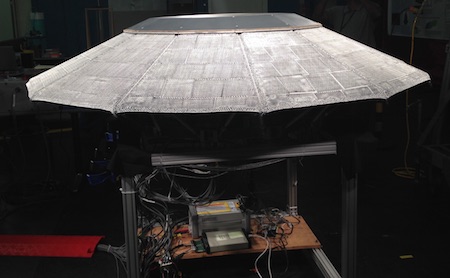Science Fiction
Dictionary
A B C D E F G H I J K L M N O P Q R S T U V W X Y Z
ADEPT Heat Shield Works For Mars

NASA's testing of the Adaptive Deployable Entry system Project (ADEPT) has been completed at the Ames Research Center. The testing determined that ADEPT would be successful in protecting a space craft entering Mars' atmosphere. Surface temperatures on the test article reached 3,100 degrees Fahrenheit.

(Adaptive Deployable Entry system Project (ADEPT))
The Adaptive Deployable Entry system Project (ADEPT) objective is to develop a semi-rigid low-ballistic coefficient aeroshell entry system concept to perform and entry descent landing (EDL) functions for planetary missions. This concept would be used to safely deploy scientific payloads or enable long-term exploration to other planets with their associated cargo needs. The deployable idea allows mission planners to develop an aeroshell design that fits within existing launch vehicle systems, and yet prior to the EDL mission segment, transform into a low ballistic coefficient configuration. Thus, atmospheric entry environments (heating, acceleration, and pressure) are significantly lowered, allowing the use of lower heat capacity TPS and lower design loads for other spacecraft components.For the ADEPT deployable concept, woven carbon fabric (which covers 90% of the deployed surface and is supported by semi-rigid ribs) is the primary drag-producing surface. Its flexibility also allows it to be stowable. The pure carbon fabric, with its high thermal conductivity, allows re-radiation from both the windward and leeward side of the fabric. This activity will include the detailed design and fabrication of a sub-scale prototype test article (approximately 2-m diameter) that will include as many flight-like and mission-traceable aspects as possible. The ADEPT proto-flight configuration will undergo integrated ground testing including numerous deployments, random vibration and acoustic testing and thermal-vac. Planning for the execution of follow-on flight-testing is on-going.
(via NASA ADEPT program
Fans of golden age sf great EE 'Doc' Smith recall the ablative heat shield used in his 1934 novel Triplanetary; the device was used to jump from a supersonic plane traveling at 2,000 miles per hour at the very edge of the atmosphere:
Back toward the trailing edges then, to a small escape-hatch beside which was fastened a dull black ball... He gasped as the air rushed out into near-vacuum... He rolled the ball out onto the hatch, where he opened it: two hinged hemispheres, each heavily padded with molded composition resembling sponge rubber......He curled up into one half of the ball; the other half closed over him and locked. The hatch opened. Ball and closely-prisoned man plummeted downward..
And as the ball bulleted downward on a screaming slant, it shrank!
...a synthetic which air-friction would erode away, molecule by molecule, so rapidly that no perceptible fragment of it would reach ground.
Via PhysOrg.
Scroll down for more stories in the same category. (Story submitted 10/3/2015)
Follow this kind of news @Technovelgy.| Email | RSS | Blog It | Stumble | del.icio.us | Digg | Reddit |
Would
you like to contribute a story tip?
It's easy:
Get the URL of the story, and the related sf author, and add
it here.
Comment/Join discussion ( 0 )
Related News Stories - (" Space Tech ")
Will Space Stations Have Large Interior Spaces Again?
'They filed clumsily into the battleroom, like children in a swimming pool for the first time, clinging to the handholds along the side.' - Orson Scott Card, 1985.
Reflect Orbital Offers 'Sunlight on Demand' And Light Pollution
'I don't have to tell you about the seven two-mile-diameter orbital mirrors...'
Chrysalis Generation Ship to Alpha Centauri
'This was their world, their planet —
this swift-traveling, yet seemingly moveless vessel.' - Nat Schachner, 1934
The First Space Warship For Space Force
'Each of the electrical ships carried about twenty men...' - Garrett P. Serviss, 1898.
Technovelgy (that's tech-novel-gee!) is devoted to the creative science inventions and ideas of sf authors. Look for the Invention Category that interests you, the Glossary, the Invention Timeline, or see what's New.
Science Fiction
Timeline
1600-1899
1900-1939
1940's 1950's
1960's 1970's
1980's 1990's
2000's 2010's
Current News
Replace The Smartphone With A Connected Edge Node For AI Inference
'Buy a Little Dingbat... electropen, wrist watch, pocketphone, pocket radio, billfold ... all in one.'
Artificial Skin For Robots Is Coming Right Along
'... an elastic, tinted material that had all the feel and appearance of human flesh and epidermis.'
Robot Guard Dog On Duty
I might also be thinking of K-9 from Doctor Who.
Wearable Artificial Fabric Muscles
'It is remarkable that the long leverages of their machines are in most cases actuated by a sort of sham musculature...'
BrainBridge Concept Transplant Of Human Head Proposed
'Briquet’s head seemed to think that to find and attach a new body to her head was as easy as to fit and sew a new dress.'
Google's Nano Banana Pro Presents Handwritten Math Solutions
'...copy was turned out in a charming and entirely feminine handwriting.'
Edible Meat-Like Fungus Like Barbara Hambly's Slunch?
'It was almost unheard of for slunch to spread that fast...'
Sunday Robotics 'Memo' Bot Has Unique Training Glove
'He then started hand movements of definite pattern...'
Woman Marries Computer, Vonnegut's Dream Comes True
'Men are made of protoplasm... Lasts forever.'
Natural Gait With Prosthetic Connected To Nervous System
'The leg was to function, in a way, as a servo-mechanism operated by Larry’s brain...'
Spidery 'Walk Me' Toyota Autonomous Wheel Chair Like Star Wars
Walk along with the emperor.
Dancing Robots Taught Dance Moves
'A clockwork figure would be the thing for you...'
Proof Of Robothood - Not A Person
'Who are you people? - Show 'em.'
Indonesian Clans Battle
'The observation vehicle was of that peculiar variety used in conveying a large number of people across rough terrain.'
The 'Last Mile' In China Crowded With Delivery Robots
Yes, it's a delivery robot. On wheels.
Tornyol Microdrone Kills Mosquitoes
'The real border was defended by... a swarm of quasi-independent aerostats.'
